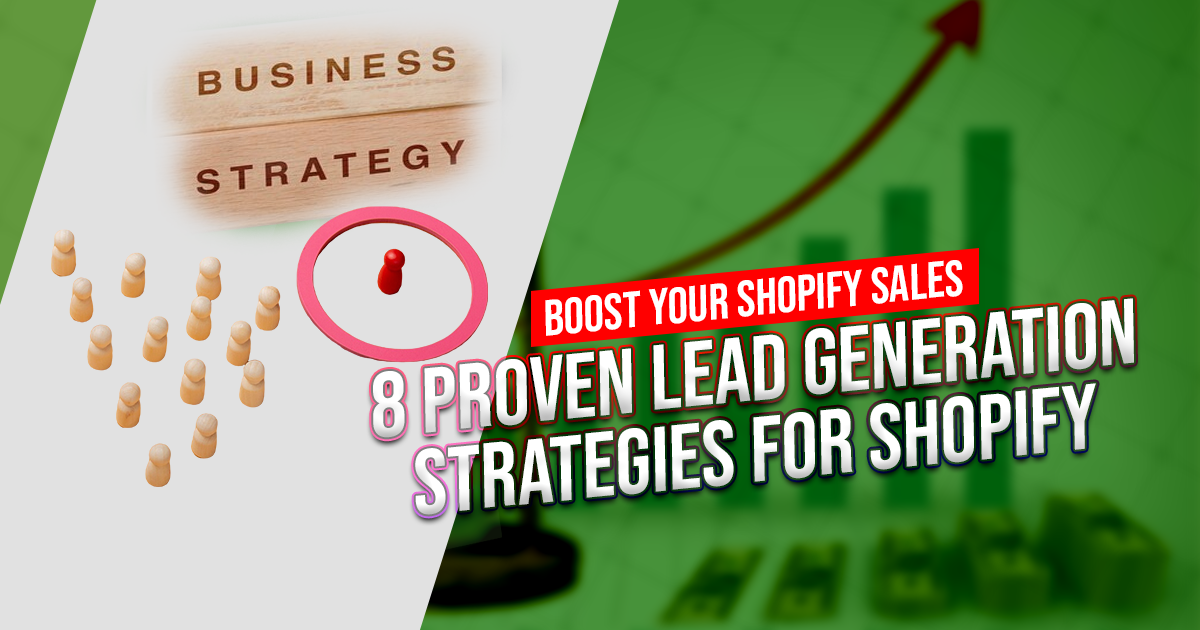
Last Updated on November 21, 2024 by Inzamamul
Because of several significant challenges, online retailers are only able to produce a little revenue in accordance with their expectations. One of their most important problems is that many buyers need help buying their desired products.
Lead generation is a process that helps organizations boost their overall revenue by increasing the number of customers who purchase their goods or services. Businesses can turn information into permanent clients if they use lead-generation tactics. Because of this, companies may see a tremendous increase in their profits.
This article will discuss the ways of Shopify lead generation.
What Is The Meaning Of Lead Generation?
Generating leads boosts your company’s income by attracting more potential and targeted customers. Many companies don’t use this method, but it’s becoming more common nowadays. A potential customer who shows interest in the products or services offered by your company but has yet to be ready to make a purchase is referred to as a lead.
Here are some statistics about lead generation from startup bonsai:
- 61% of marketers regard generating leads as the most difficult task
- More than half of all marketers (53%) prefer spending at least 50% of their money on generating leads
- Marketers are optimistic that marketing automation will increase lead generation by 80%
- In comparison to outbound marketing, content marketing produces three times as many leads at a fraction of the price
- A remarkable 80% of B2B organizations depend on content marketing for lead generation
What Are The Reasons for Losing Leads in B2B Business?
Some leads are more valuable than others. Regarding investing time and resources into a lead, it is crucial to determine how qualified the lead is. In business, time spent on leads that are unlikely to become customers is wasted if they are not properly qualified. Here we will discuss some of the reasons that could be cited as reasons for losing leads:
Reason 1- Your Company Requests Too Much Information
The first reason for losing leads is asking each customer for details. Find a flexible form for the lead generation process and demand as little information as possible. If you ask too many unnecessary questions of your customers, they will not finish the form and leave your website.
If a lead form contains fewer fields, there is a greater chance that a visitor will fill it out and submit it. Providing an incentive form is also a good idea.
Reason 2- You Are Sending Too Many Emails
Avoid sending too many emails to a new lead. Stop flooding your customers’ inboxes with promotional or generic emails. This needs to be more professional and give the impression that you are desperate and will not help you get new prospects.
Your goal should be to find a happy medium between the quantity of contact you have with them and the number of times you send them weekly emails. You want your potential customers to remember your company, but you don’t want to irritate them by being too persistent with your presence in front of them.
Reason 3- There Is A Lack Of Communication Systems
Timing is essential in the process of getting leads. If your marketing or sales team makes prospects wait too long for an answer to a question, the likelihood of a lead decreases.
Marketers say a lead is nine times more likely to become a customer if followed up within five minutes of an online inquiry.
Make a file of common problems and solutions. If it takes too long to respond, you should look for other options because you want to find a solution to your problem as soon as possible.
Reason 4- Your Lead Generation Team Quickly Gives Up
Another typical error marketing and sales teams make is giving up on leads. A B2B buyer asks lots of questions before purchasing. So, when generating B2B leads, it is vital to remember that the first person your company may talk to maybe someone other than the ultimate decision-maker. Instead, they will talk to other people before taking a step.
Your team may agree on a specific number of contact points prospects need and a schedule for the lead nurturing process to reduce the risk of losing out on promising leads. Sending prospective clients a customized email with marketing material that has been shown to convert leads into customers is one way to reduce the time it takes to close a deal.
Reason 5- Your Company Provides Offers Randomly
Lead generation landing pages are a great way to get the attention of prospects and offer them a discount. Every effort to get leads must be clear about what is being offered. A free demo or a free trial is a good idea to generate interest in your customer before providing an offer.
In addition, it should have a clear call to action (CTA) that encourages people to do something. But if a landing page needs to clarify what offers you are giving away, that can be problematic. Do not make an offer randomly. Whenever a request is over, make a new one.
Potential Ways of Shopify Lead Generation!
Generating leads is a crucial aspect of running a successful Shopify store. There are several potential ways to generate leads for Shopify, each with its own advantages and challenges. Let’s see what they are-

- Increasing Brand Visibility
- Using Marketing Automation Application
- Create a Website That is Easy to Navigate
- Leverage Different Methods to Develop Leads
- Your Content Needs Some Polishing
- You are not Concerned About CTA
- Your Website is not Mobile Friendly
- Use A User-Friendly Third Party App
Way 1- Increasing Brand Visibility
Increasing the traffic of your eCommerce business should be the first thing you need to work on. Whenever your customer wants to purchase anything, they research the product online. As an owner of Shopify, you should prioritize your customer and follow a good SEO strategy.
Proper SEO of your content improves the chances of being shown on the top page of search engine results. When your pages begin ranking, it is easier for prospects to locate your business.
Search engine optimization may also help you efficiently use the funds you have allocated for marketing. Your eCommerce website will rank better and attract more clients if you implement a well-planned search engine optimization plan.
Regarding your eCommerce website,
- you should try to avoid duplicate publishing content.
- Get started by crafting product descriptions that are original, interesting, and include strategic keywords.
- Ensure that the product photos are optimized by adding an ALT tag.
- Create URL structures that are acceptable to boost your site’s visibility in the first place. It is essential to keep the navigation simple, and you should avoid using broken links.
Way 2- Using Marketing Automation Application
You may automate the lead-gathering process with the help of a marketing automation application for your Shopify store. This process lets you gather information about leads from different sources.
In addition, it also provides benefits with activities such as the creation of landing pages, the management of email marketing campaigns, the collection of data from a variety of contact points, and so on.
The actual value of marketing automation shows when it engages with leads by sending them the appropriate message at the proper time. After getting information about your customer, marketing automation tools customize the message to reflect those findings through emails.
To provide a trouble-free marketing automation method, Upselling, and cross-selling are two strategies that can be used to raise the average order value (AOV).
You can keep your current consumers stable by offering customers a subscription service. Make use of a newsletter and lead generators to increase your contact list. Create personalized emails for different consumer groups using segmentation data.
Way 3- Create A Website That Is Easy To Navigate
Especially if you have yet to gain experience with web development, Shopify makes it simple to set up a professional eCommerce website. You need to design a user-friendly website looks professional and is simple to understand to attract potential customers.
When visitors arrive at your website, it should take them a few seconds to get to the section they are looking for. Ensure that your product descriptions are clear and that the information on shipping and delivery is simple to comprehend. Moreover, the structure of your website and the images you use are attractive and informative.
Way 4- Leverage Different Methods To Develop Leads
Your attempts to enhance your Shopify lead generation may be improved in several methods, some of the most successful of which include social media and influencer marketing, content marketing, pay-per-click advertising, and email marketing. A multi-faceted plan that can connect with your potential customers in various ways is essential.
Be mindful of the fact that even if a potential customer sees your e-commerce website in one location. For instance, on social media, consumers may only click on it once they’ve seen it several times.
If you communicate with leads through various channels, you can keep your brand at the top of their minds and encourage them to come to check out what you offer in person.
Way 5- Your Content Needs Some Polishing
Your content must be great even if you have the best marketing campaign. If you don’t do this, the strategies you try to get leads won’t work. Regarding marketing, content is essential and can only be replaced by something else.
If you think you’re doing everything right to get leads but still not getting enough, you might want to look more closely at the information you’re giving.
Content can come in many different forms. For your business, it could be a frequently updated blog, a creative video, or a set of stunning images.
No matter what it is, it should be enough to set you apart from your competitors and show how knowledgeable you are about the product or service you want to sell or provide for the money.
Even though most companies know how important content is for lead generation and future sales, this is still where most fail.
According to a 2016 study by the Content Marketing Institute, only 30% of B2B marketers think their companies are doing well with content marketing. This shows a big area where there is an opportunity for improvement.
Way 6- You are Not Concerned About CTA
The “call to action,” or “CTA,” is essential to getting people to sign up for your list. Whether at the end of a blog post or in an email, the “call to action” should make it easy for readers to get in touch with you in the best way for them.
A direct call to action might tell readers to go to the company’s website or give them a phone number and a specific person to call. In other direct calls to action, readers might be given an email address to send questions.
On the other hand, a call to action could be a term or keyword linked to another page where users can give their contact information, learn more about a product, or even make a purchase. This kind of call to action needs to be more direct and subtle.
It’s shocking to find out that as many as 70% of websites for small businesses don’t have a call to action. This is not only bad for sales but also for the company’s reputation.
A call to action is a natural way to get people reading your content to take action. This makes them valuable leads, which could lead to conversions and sales if the proper steps are taken.
Way 7- Your Website Is Not Mobile Friendly
Currently, over 64% of people in the United States own a smartphone that can connect to the Internet, and this percentage is rising daily. More and more people are getting used to using their smartphones; viewing websites on a laptop or desktop computer is no longer required.
A mobile version of your website is essential to satisfy users who may find mobile more comfortable. Even if customers use smartphones, you can make it much easier for them to submit opt-in forms to provide you with relevant leads by developing and making accessible a mobile version of your Shopify store.
Way 8- Use A User-Friedly Third Party App
If you are a businessperson at Shopify, then to gather leads, you should add some extra perks to your store. As a part of adding perks, using different third-party apps is really beneficial.
For example- In a product personalization business, using a product configurator, and in a B2B wholesale business, using a bulk order app is a wise decision. These applications increase customer satisfaction and overall user experience more than their competitor because they mostly contain several features unavailable in the default Shopify.
Let’s look at a product personalizer allowing a custom businessperson to add the same perk to this business that an ordinary businessperson can not.

This is an interface of a product personalizer that allows its users to add different designs p featured on the product they want to customize. This type of feature actually helps to generate leads because these amazing features will make them repetitive and loyal.
Not only product personalization app, similarly using a marketing automation app or cart abandonment email app is also helpful to lead generation at the Shopify store.
Bottom Line
To conclude, Shopify lead generation is essential to get targeted customers. Moreover, attracting and targeting customers with service is essential to create brand value in Shopify. Whenever you discover the causes of losing the lead, follow our ways to cope.


